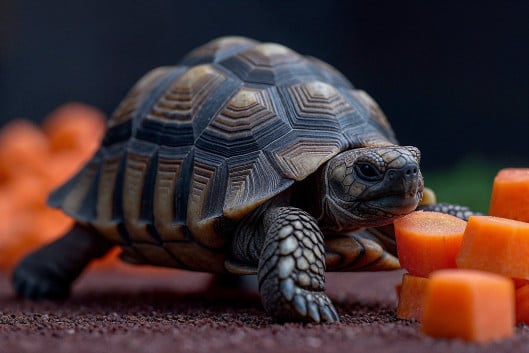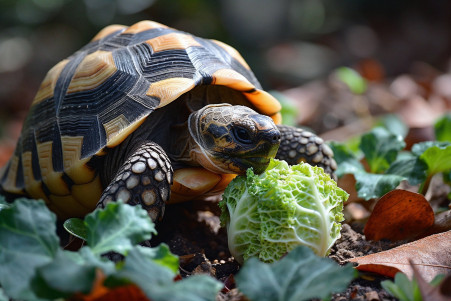Can Tortoises Eat Celery? Understanding Safe Tortoise Diets
26 January 2024 • Updated 28 January 2024

Tortoises eat a wide variety of leafy greens, but you may be wondering if you can feed them celery. Celery is not the best option for tortoises because it is high in oxalates, which can block calcium absorption, and it has a poor calcium to phosphorus ratio. As a result, celery should be fed to tortoises in moderation and as part of a diet that includes a variety of other foods.
This article will take a deep dive into tortoise nutrition, combining information from herpetology, veterinarians, and zoos to give you a comprehensive understanding of what tortoises should eat. We will look at the nutritional content of celery and how it impacts tortoise nutrition, what a healthy tortoise diet looks like, and where treats like celery fit in.
By the end of this article, you will have the information you need to feed your tortoise a diet that is both responsible and nutritious.
Can tortoises eat celery?
How Celery Affects Tortoise Health
There are several reasons to be concerned about the impact of celery on a tortoise’s diet. First, celery is high in oxalates, especially in the leaves, which can bind to calcium and make it less available to the tortoise.
Since calcium is so important to tortoises for shell and bone health, nerve function, and muscle movement, the presence of oxalates in celery can make it difficult for tortoises to get the calcium they need, leading to deficiencies that can have serious health consequences.
In addition, the calcium to phosphorus ratio in celery is not ideal for reptiles, including tortoises. This ratio is important because it affects bone density and overall growth. A study in PMC suggests that the ideal calcium to phosphorus ratio for bone health is 1–2:1, a ratio that celery does not meet.
Finally, celery is high in sodium, which can be harmful to tortoises if they consume too much of it.
The Tortoise Table recommends against feeding celery to tortoises on a regular basis because of its high carbohydrate and sodium content.
A study in the Journal of Animal Physiology and Animal Nutrition notes that feeding tortoises foods high in oxalates or sodium can lead to health problems like kidney stones and other metabolic issues, which can result in the accumulation of calcium oxalate and potential renal failure. While celery is not toxic, these nutritional factors make it a less than ideal food for tortoises, which underscores the importance of dietary variety and care in choosing the foods you feed your pet.
How to Create a Healthy Diet Plan for Your Tortoise
A diet that provides all of the essential nutrients tortoises need, including water, protein, energy, vitamins, and minerals, is important for their overall health.
According to Mazuri, it’s important to make sure that the diet is tailored to the tortoise’s species, age, and other individual needs to make sure that the nutrients are in the right balance to support their overall health.
Tortoises need access to water for drinking and soaking that is especially important in warm weather, and protein to support muscle and antibody development. While tortoises aren’t very active animals, energy is still an important part of their diet, especially for younger tortoises.
According to the Merck Veterinary Manual, fiber is an important part of a tortoise’s diet because it helps support normal gut physiology and is a major source of energy. In the wild, tortoises eat a variety of plants to make sure that they get the fiber and other nutrients that they need.
Kapidolo Farms notes that it’s important to make sure that tortoises have a varied diet and warns against feeding tortoises a diet that is too monotonous because it may not provide all of the nutrients that they need.
A varied diet that includes a variety of leafy greens and vegetables will help make sure that tortoises get the nutrients that they need and avoid some of the health problems that can come from an unbalanced diet.
The most important thing is to make sure that the tortoise’s health and well-being are supported, and that means making sure that they have access to a variety of foods, which will allow for a diet that includes some treats and a wide range of plant-based foods.
What Do Tortoises Eat?
Vegetables are a key part of a tortoise’s diet, providing important nutrients, vitamins, and fiber that are necessary for their well-being. Tortoise Trust notes that tortoises, especially those from the Mediterranean, do best on a wide range of herbaceous plants, including leafy greens that are high in calcium and low in protein.
Some of the most popular vegetables for tortoises are dandelion, kale, and clover, all of which are high in calcium and other vitamins.
Before feeding, make sure to wash and cut the vegetables so that they are easy for the tortoise to eat. According to Tortoise Table, how often you should feed your tortoise depends on its age and species, with younger tortoises requiring daily meals and adults doing well with meals every other day.
Celery should be fed to tortoises in moderation because it is high in oxalates. Blue Lizard Reptiles recommends providing a variety of safe plants to prevent your tortoise from eating too much of any one thing and to prevent them from getting bored with their diet.
This means that celery can be fed to tortoises as an occasional snack instead of a regular part of their diet, which will help ensure that they get a variety of nutrients from their food.
Risk Assessment: Celery in a Tortoise’s Diet
The risks of feeding celery to tortoises are unique to the oxalate and sodium content in the vegetable. According to The Tortoise Table, oxalate-rich foods can cause dietary imbalances, including the possibility of calcium deficiency, as oxalates bind to calcium and prevent it from being absorbed, which is important for a tortoise’s shell and bone health.
The sodium content in celery is also a concern. A study published in PubMed found that turtles with a high salt intake had changes in their plasma renin activity, and while this has not been studied in tortoises, it suggests that high sodium levels could lead to fluid and electrolyte imbalances. This shows the importance of limiting high-sodium foods like celery in a tortoise’s diet.
To avoid overfeeding celery to tortoises, it should be fed as an occasional treat rather than a regular part of their diet. Tortoise owners should also be on the lookout for signs of dietary imbalances, including changes in the quality of the tortoise’s shell, lethargy, and digestive problems.
When new foods like celery are introduced, it’s important to monitor the tortoise’s health. If any negative changes are noticed, tortoise owners should review their pet’s diet and talk to their veterinarian to make sure their tortoise stays healthy.
Final Thoughts on Celery and Tortoise Diets
Celery can make a nice, crunchy snack for tortoises, but it should be fed in moderation. As we’ve learned, celery’s high oxalate and sodium levels and its diuretic nature all make it a potential concern for tortoises.
Be sure to feed celery with caution to avoid the risk of calcium absorption interference, which is important for shell and bone health. Hepper explains that while celery isn’t dangerous, it’s not very nutritious for tortoises, so it should be a small part of their diet.
A well-rounded, diverse diet is important for the health of tortoises. This diet should be similar to what tortoises eat in the wild and include leafy greens, vegetables, and possibly animal proteins for omnivorous tortoises, according to Tortoise Owner. A diet that’s high in fiber and other important nutrients is necessary to keep these special reptiles healthy, according to Pet Keen.
Work with a vet to make sure you’re feeding your tortoise a diet that’s right for their individual needs. If you decide to feed your tortoise celery, make sure you feed it in moderation and that it’s part of a diet that’s full of other important nutrients. Following these tips will help ensure that your tortoise lives a long and healthy life.


